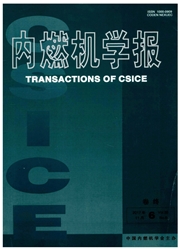

 中文摘要:
中文摘要:
为研究纳米级V2O5与MoO3催化剂表面结构对其催化氧化碳烟活性的影响,以TiO2为载体,采用等体积浸渍法制备了不同负载率(5%、10%、20%、40%)的V2O5/TiO2与MoO3/TiO2催化剂,通过扫描电镜(SEM)、X射线衍射仪(XRD)对比研究了2种催化剂在TiO2载体上的分散状态及物相结构.以Printex-U碳黑为试验用碳烟,采用热重分析仪对V2O5与MoO3催化剂催化碳烟氧化的活性进行了比较.结果表明:V2O5与MoO3在TiO2载体上均存在一个单层分散饱和阈值,分别为V20(负载率为20%,下同)、Mo10,在该阈值前后活性组分在载体上分别以单层分散状态和明显的晶态存在.对于V2O5催化剂,其最佳催化活性出现在负载率接近单层分散饱和阈值时,与无催化状态相比,Ti(起燃温度)、Tp(最大失重率温度)以及Tf(燃尽温度)分别下降了69.1、46.0、23.0℃,有明显的阈值效应.而对于MoO3催化剂,因其自身低熔点性而表现出良好的表面迁移能力,再加上α-MoO3晶体特有的层状结构,使其可释放出更多的晶格氧,随着负载率的增加,该催化剂催化氧化碳烟活性持续增加,并且未观察到明显的阈值效应.研究显示,在相同负载率下,MoO3催化剂催化氧化碳烟活性均高于V2O5催化剂.
 英文摘要:
英文摘要:
The effects of surface structure and appearance of active species on nano-scale V2O5/TiO2 and MoO3/TiO2 catalysts' catalytic performances for diesel soot catalytic oxidation were investigated. The search provided a theoretical basis for development of novel catalysts, enhancement of the soot catalytic oxidation efficiency and reduction of PM emissions. The catalysts with different loading rates (5% , 10% , 20% , 40% ) were prepared by an impregnation method, and the dispersing phase and physical-chemical attributes of active species loaded on TiO2 were characterized using Scanning Electron Microscope (SEM) and X-Ray diffraction (XRD). Printex-U carbon black was utilized to replace the practical engine soot. The catalytic oxidation activity over soot was evaluated using a TG/DTA analyzer, and was evaluated by the ignition temperatures (Ti), the weight loss peak temperatures (Tp) and the burnout temperatures (Tf). The results showed that there was a monolayer dispersion threshold, which was V20 and Mo10 for V2O5 and MoO3 catalysts separately, when 69.1, 46.0 and 23.0 ℃ respectively. However, as for the MoO3 catalysts, the characteristic temperatures decreased with increased loading rate, which implies that the catalytic activity was enhanced. This is because the favorable surface migration of active species resulted from lower melting point and more lattice oxygen provided by the α-MoO3 crystal of the layer structure. Therefore, no threshold effect was perceivable for the MoO3/TiO2 catalyst. Moreover, with the same loading rate, the MoO3 catalysts normally present higher aeti,lities than the V2O5 catalysts.
 同期刊论文项目
同期刊论文项目
 同项目期刊论文
同项目期刊论文
 期刊信息
期刊信息
